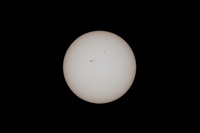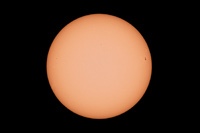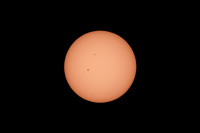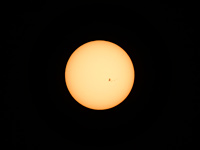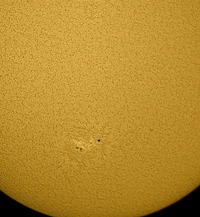 |
2020 November 8; in Ha light imaged by a monochrome video camera. 1000 frames aligned and stacked with colour added later. The Sun is starting to wake up following its prolonged period at minimum activity. Active regions AR2780 and AR2781 are clearly visible. A closer view. |
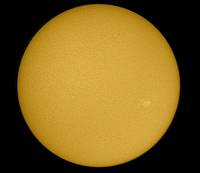 |
2020 October 28; in Ha light imaged by a monochrome video camera. 1000 frames aligned and stacked with colour added later. The Sun is starting to wake up following its prolonged period at minimum activity. Active region AR2778 is lower right. Here is a closer view of AR2778. |
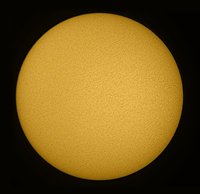 |
2019 September 26; in Ha light - imaged by a monochrome video camera. 800 frames aligned and stacked with colour added later. No sunspots, prominences or filaments, but lots of nice chromospheric detail. |
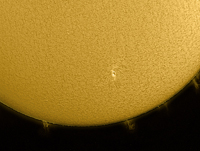 |
2018 August 1; new sunspot AR2717 and prominences around the sun's disk |
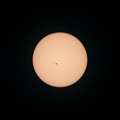 |
2017 July 11; despite the Sun running down towards minimum activity, nice sunspot groups do appear from time to time. This complex one is AR2665. |
-tn.jpg) |
2016 August 29; a sun of low activity, but still plenty to see and enjoy. Here's the white light view. |
-tn.jpg) |
2016 August 8; a sun of low activity, but some beautiful prominences to enjoy. |
| 2015 March 14; the very active groups AR2297 and AR2301 have rotated Earthwards. These groups produced significant M- and X-class flares almost daily and were the cause of the great aurora observed during 17th -19th March (UTC). | |
| 2014 October 30, N to top: AR2192 has rotated to the limb and is heavily foreshortened, the show is over for now and only a few small spots are visible. Careful examination of the limb near 2192 shows slight irregularities indicating that the sunspot is slightly below the average "surface" level of the photosphere - the Wilson effect, discovered in 1769. | |
| 2014 October 25: AR2192 is centre stage. It was the source of many M- and X-class flares, but disappointingly few CME's were sent Earth-bound. Here's a close up of AR2192. B&W image taken through a Takahashi TOA-130 (with a white-light filter on front) and an SBIG11000M camera and Ha filter.; N is approx at 4o'clock | |
| 2014 October 21: AR2192 is the huge sunspot lower left and the largest sunspot for over 10 years, source of many M- and several X-class flares | |
| 2014
September 13, a white light image, with N to top; the large sunspot
group AR2158 is rotating away from the Earth. This group was responsible for one X- and three M-class flares around the 10th September that led to a G3 geomagnetic storm and strong auroras. Unfortunately the CMEs from these flares hit during daytime here in Victoria, Australia, and no auroras were visible |
|
| 2014 July 11, a white light image, with N to top; the large and complex sunspot groups AR2109, AR2108 and AR2104 are rotating away from Earth. Unfortunately these spots did not exhibit much flare activity whilst Earth-facing | |
| 2014 January 8; a white light image, with N to top, showing the complex region around the huge spot, AR1944, which unleashed an X-1 class flare on the 7th. Here's an image in Ha taken at the same time | |
| 2013 November 16, white light image with N to top: an unusually large number of spots and groups are visible for this cycle. The large spot is AR1899 and the complex group lower right is AR1900 | |
| 2013 November 2 at the VicSouth Star Party, white light image with N to top: sunspot groups AR1884 and AR1885 are prominent. Imaged through Gavan Salter's solar telescope | |
| 2013 October 10; a couple of large spots (large for this cycle, at least) are visible and several nice prominences around the edge. A few filaments and plages too | |
| 2013 July 8; a white light image showing the large southern hemisphere sunspot group AR1785. Up to this time this solar maximum the Sun had been unusually quiet in the southern hemisphere. Here's an image in Ha taken at the same time showing over a dozen prominences, plages and several filaments | |
| 2013 May 10, a white light image. An image taken at the end of a memorable annular eclipse north of Tennant Creek, Northern Territory, Australia. The sunspots to the right are AR1732 and AR1734 | |
| 2012 October 28; AR1598 is the complex group lower left of centre | |
| 2012 May 10; the large and complex sunspot group AR1476, source of several M-class flares, is rotating into a direct Earth-facing position; 500mm lens with 1.4X converter | |
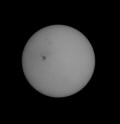 |
2005 January 17, the very large and active sunspot group AR720 had already unleashed several M-class and one X2-class flare towards Earth |
 |
2003 October 26; a white light image through a Takahashi 3" refractor showing the huge and complex sunspot groups AR10484 and AR10486 (lower right). Telescope courtesy of Douglas Cooper, SAS. AR10486 unleashed the 3rd most powerful solar flare ever recorded, X28, on the 28th October 2003 which produced a very bright aurora display on the 31st October |
 |
2001 October 31; a few days later the large spot unleashed a coronal mass ejection which produced colourful auroras on the 5th and 6th of November; 15cm f/4 reflector used |
 |
2001 March 31; the largest sunspot group was responsible for the burst of superb auroral displays during the last week of March 2001; 15cm f/4 reflector used |
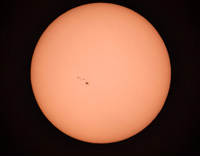
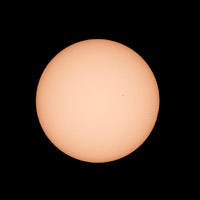
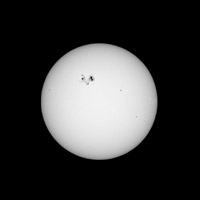
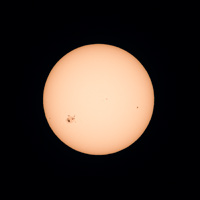
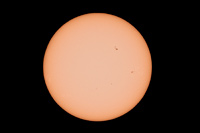
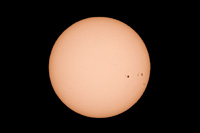
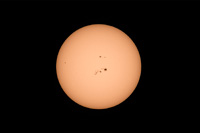


-vsm.jpg)
